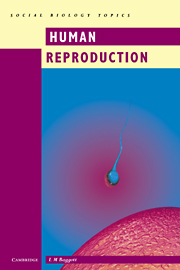Book contents
- Frontmatter
- Contents
- 1 Human reproductive strategies
- 2 Gamete production
- 3 Fertilisation
- 4 Implantation and pregnancy
- 5 Birth and lactation
- 6 Contraception
- 7 Human infertility: background and causes
- 8 Human subfertility: options and treatment
- 9 Ethical and moral considerations of fertility and infertility
- Index
3 - Fertilisation
Published online by Cambridge University Press: 05 June 2012
- Frontmatter
- Contents
- 1 Human reproductive strategies
- 2 Gamete production
- 3 Fertilisation
- 4 Implantation and pregnancy
- 5 Birth and lactation
- 6 Contraception
- 7 Human infertility: background and causes
- 8 Human subfertility: options and treatment
- 9 Ethical and moral considerations of fertility and infertility
- Index
Summary
Unless they encounter each other and complete the process of fertilisation, the gametes – both sperm and oocyte – are destined to die quite quickly (sperm within 45 hours, oocytes within 24 hours). The oocyte, with its complex cytoplasm, is the only cell in the body which has the potential to become a new human being, but without the contribution of the sperm genome its development cannot proceed. Fertilisation, the union of male and female gametes to form a zygote, is not a single event, but a continuum of subtle interactions and their outcomes.
Final preparation of the gametes
Before they are able to join to form a zygote, the sperm and oocyte must undergo final changes which enable fertilisation to occur. The process of gametogenesis (chapter 2) has resulted in the production of sperm from the seminiferous tubules of the testis, and oocytes in the dictyate stage of developmental arrest.
Epididymal maturation of sperm
The epididymis (figures 2.4 and 3.1) is a long, much coiled duct lined with columnar epithelium which has both secretory and absorptive functions. When the sperm enter the head of the epididymis from the testis, they are immotile and unable to fertilise an oocyte. During their passage along the length of the epididymal duct, the sperm acquire twitching movements at first, followed by full motility with active forward progression. The mature sperm are stored in the tail of the epididymis until ejaculation.
- Type
- Chapter
- Information
- Human Reproduction , pp. 22 - 32Publisher: Cambridge University PressPrint publication year: 1997



